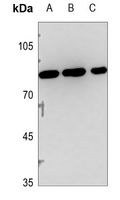Anti-PNPLA8 Antibody
Rabbit polyclonal antibody to PNPLA8
- SPECIFICATION
- CITATIONS
- PROTOCOLS
- BACKGROUND

Application
| WB |
|---|---|
| Primary Accession | Q9NP80 |
| Reactivity | Human, Rat, Rabbit, Monkey |
| Host | Rabbit |
| Clonality | Polyclonal |
| Calculated MW | 88477 Da |
| Gene ID | 50640 |
|---|---|
| Other Names | IPLA22; IPLA2G; Calcium-independent phospholipase A2-gamma; Intracellular membrane-associated calcium-independent phospholipase A2 gamma; iPLA2-gamma; PNPLA-gamma; Patatin-like phospholipase domain-containing protein 8; iPLA2-2 |
| Target/Specificity | KLH-conjugated synthetic peptide encompassing a sequence within the C-term region of human PNPLA8. The exact sequence is proprietary. |
| Dilution | WB~~WB (1/500 - 1/1000) |
| Format | Liquid in 0.42% Potassium phosphate, 0.87% Sodium chloride, pH 7.3, 30% glycerol, and 0.09% (W/V) sodium azide. |
| Storage | Store at -20 °C.Stable for 12 months from date of receipt |
| Name | PNPLA8 (HGNC:28900) |
|---|---|
| Synonyms | IPLA22, IPLA2G |
| Function | Calcium-independent and membrane-bound phospholipase, that catalyzes the esterolytic cleavage of fatty acids from glycerophospholipids to yield free fatty acids and lysophospholipids, hence regulating membrane physical properties and the release of lipid second messengers and growth factors (PubMed:10744668, PubMed:10833412, PubMed:15695510, PubMed:15908428, PubMed:17213206, PubMed:18171998, PubMed:28442572). Hydrolyzes phosphatidylethanolamine, phosphatidylcholine and probably phosphatidylinositol with a possible preference for the former (PubMed:15695510). Also has a broad substrate specificity in terms of fatty acid moieties, hydrolyzing saturated and mono-unsaturated fatty acids at nearly equal rates from either the sn-1 or sn-2 position in diacyl phosphatidylcholine (PubMed:10744668, PubMed:10833412, PubMed:15695510, PubMed:15908428). However, has a weak activity toward polyunsaturated fatty acids at the sn-2 position, and thereby favors the production of 2-arachidonoyl lysophosphatidylcholine, a key branch point metabolite in eicosanoid signaling (PubMed:15908428). On the other hand, can produce arachidonic acid from the sn-1 position of diacyl phospholipid and from the sn-2 position of arachidonate-containing plasmalogen substrates (PubMed:15908428). Therefore, plays an important role in the mobilization of arachidonic acid in response to cellular stimuli and the generation of lipid second messengers (PubMed:15695510, PubMed:15908428). Can also hydrolyze lysophosphatidylcholine (PubMed:15695510). In the mitochondrial compartment, catalyzes the hydrolysis and release of oxidized aliphatic chains from cardiolipin and integrates mitochondrial bioenergetics and signaling. It is essential for maintaining efficient bioenergetic mitochondrial function through tailoring mitochondrial membrane lipid metabolism and composition (PubMed:28442572). |
| Cellular Location | Endoplasmic reticulum membrane {ECO:0000250|UniProtKB:Q5XTS1}; Single-pass membrane protein Mitochondrion membrane; Single-pass membrane protein. Peroxisome membrane; Single-pass membrane protein |
| Tissue Location | Expressed in parenchymal tissues including heart, skeletal muscle, placenta, brain, liver and pancreas. Also expressed in bronchial epithelial cells and kidney. Highest expression is observed in skeletal muscle and heart. |

Thousands of laboratories across the world have published research that depended on the performance of antibodies from Abcepta to advance their research. Check out links to articles that cite our products in major peer-reviewed journals, organized by research category.
info@abcepta.com, and receive a free "I Love Antibodies" mug.
Provided below are standard protocols that you may find useful for product applications.
Background
KLH-conjugated synthetic peptide encompassing a sequence within the C-term region of human PNPLA8. The exact sequence is proprietary.
If you have used an Abcepta product and would like to share how it has performed, please click on the "Submit Review" button and provide the requested information. Our staff will examine and post your review and contact you if needed.
If you have any additional inquiries please email technical services at tech@abcepta.com.













 Foundational characteristics of cancer include proliferation, angiogenesis, migration, evasion of apoptosis, and cellular immortality. Find key markers for these cellular processes and antibodies to detect them.
Foundational characteristics of cancer include proliferation, angiogenesis, migration, evasion of apoptosis, and cellular immortality. Find key markers for these cellular processes and antibodies to detect them. The SUMOplot™ Analysis Program predicts and scores sumoylation sites in your protein. SUMOylation is a post-translational modification involved in various cellular processes, such as nuclear-cytosolic transport, transcriptional regulation, apoptosis, protein stability, response to stress, and progression through the cell cycle.
The SUMOplot™ Analysis Program predicts and scores sumoylation sites in your protein. SUMOylation is a post-translational modification involved in various cellular processes, such as nuclear-cytosolic transport, transcriptional regulation, apoptosis, protein stability, response to stress, and progression through the cell cycle. The Autophagy Receptor Motif Plotter predicts and scores autophagy receptor binding sites in your protein. Identifying proteins connected to this pathway is critical to understanding the role of autophagy in physiological as well as pathological processes such as development, differentiation, neurodegenerative diseases, stress, infection, and cancer.
The Autophagy Receptor Motif Plotter predicts and scores autophagy receptor binding sites in your protein. Identifying proteins connected to this pathway is critical to understanding the role of autophagy in physiological as well as pathological processes such as development, differentiation, neurodegenerative diseases, stress, infection, and cancer.


